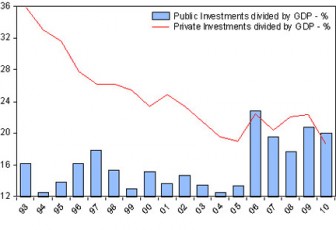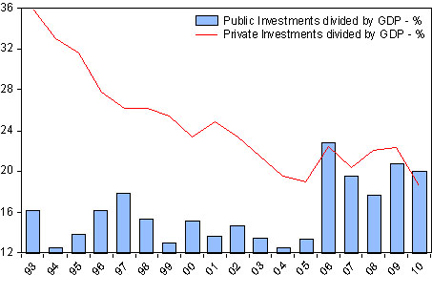Dear Editor,
In your recent report (SN, April 15) President Jagdeo noted an upsurge in investments. I take it that the President is alluding to private investments in Guyana. The official data, however, will not support the President’s contention. The essential point of this letter is as follows: while there have been some small-scale investments in the private sector, in the aggregate, private investments have declined since 1992. If we examine the private investment rate – that is total private investment divided by GDP – we will see a decline since 1992. While welcome, the sole proprietorship businesses (roti shops, fast food outlets and shopping malls which sell mainly foreign manufactured goods) alluded to by President Jagdeo are not enough to bring about a 7 to 8% GDP growth rate.
 Only such a high rate of growth could generate the kind of income and job growth that are needed to put a dent in much of the social degeneracy we witness under the current administration. High growth rates can place people in jobs and instil the work spirit needed to dent alcohol abuse, suicide, domestic violence, robberies and general hopelessness among our countrymen and women. Given the low rate of economic growth we saw under President Jagdeo, the country could have been even more unpleasant had it not been for the remittances that finance family consumption and a very large underground economy (a recent study suggested the underground economy is around 90% of official GDP).
Only such a high rate of growth could generate the kind of income and job growth that are needed to put a dent in much of the social degeneracy we witness under the current administration. High growth rates can place people in jobs and instil the work spirit needed to dent alcohol abuse, suicide, domestic violence, robberies and general hopelessness among our countrymen and women. Given the low rate of economic growth we saw under President Jagdeo, the country could have been even more unpleasant had it not been for the remittances that finance family consumption and a very large underground economy (a recent study suggested the underground economy is around 90% of official GDP).
High GDP growth rates are also crucial for paying higher salaries to teachers, nurses, police officers, soldiers and all other public servants. Guyana is not in a position to print money and pay higher salaries. No one in the international community will take the Guyana dollar for cars, gasoline and other critical imports. Therefore, large private foreign and diaspora investments are needed to generate exports, foreign exchange and jobs that are needed to dent the hopelessness. The small-scale sole proprietorships, although necessary, are not yet in a position to generate the kind of exports that the country needs. The mom and pop roti shops and other businesses will only grow up if we have a core set of large corporations that will form linkages with the small-scale enterprises. That the economy is not at this stage is testimony to the failure of PPP economic policy and the LCDS. Massive doses of private investments, therefore, are crucial for all of this to occur.
Both the quantity and quality of private investments matter. Some sectors of the economy will naturally generate higher paying jobs, while the retail trade, fast food stores and roti shops will tend to create lower paying jobs (not that these investments are unimportant because sole proprietorships provide a good living for the owner). Also investments in pure resource extractions (such as the gold extracted by large enterprises and the proposed exports of raw timber logs by the Indian firm) will bear temporary fruits, if any. However, if most of the processing of natural resources is done at home then there will be higher salaries for workers.
There is also the issue of the control of business activities in Guyana by the PPP government – which I have called an elected oligarchy. The resources of the country are developed only when chosen friends and families emerge. The masses of workers, meanwhile, grind it out in poverty or just above subsistence level. I continue to argue that this slow rate of private investment is a deliberate strategy since bringing in more foreign and diaspora investors families emerge. The masses of workers, meanwhile, grind it out in poverty or just above subsistence level. I continue to argue that this slow rate of private investment is a deliberate strategy since bringing in more foreign and diaspora investors would imply ceding some control of economic resources.
In spite of what the President said, the data show that the rate of private investment has declined since 1992. See below for a chart which graphs the rate of private investments and government investments since 1992. The trend in the private investment rate does not support the contention of President Jagdeo. The line graph moved downward from 35.8% in 1992 to 19% in 2010. The data came from the Bank of Guyana Annual Reports. The government investment rate (shown by the bars), on the other hand, is showing an upward trend now on par with the lower private investment rate. The government investment rate in 1992 was 16%. In 2010 it rose to 20%. This decline in private investment meant that the poor stayed poor or just around subsistence level. Meanwhile, some officials became very rich since 1992. Ironically, the disciples of Lenin and the economics of the Soviet Union have given us unprecedented inequality in wealth and incomes.
The AFC has a serious economic plan that will address this inequality and raise the investment rate to at least 40% of GDP. I urge young people to read the Action Plan because massive doses of private investments are crucial for jobs and higher living standards. I also urge small business owners to read the Action Plan because their businesses will be better served when we have a core set of large-scale corporations generating jobs, paying taxes and establishing business linkages.
Yours faithfully,
Tarron Khemraj





